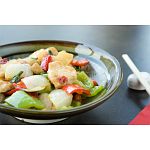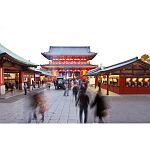
You’re supposed to eat a piece of sushi in one go so as not to destroy the artistry of the chef! The most popular types of sushi are nigri, pieces of fish on top of rice balls, norimaki which is rice and seafood rolled inside a sheet of dried seaweed, and inari, which is a ball rice in a tofu bag and fried. Most Sushi restaurants are those with the conveyor belts with food passing in front of the customers on plates colour-coded for price – these are called kaiten sushi shops. Just sit down at the counter, pour yourself some soy sauce in the little bowl, help yourself to ginger and tea which cleanse your palate between dishes, and you’re ready - just pick up whatever takes your fancy from the belt, dip it in the soy sauce and eat it either with the chopsticks, or your fingers. The coloured plates help the restaurant calculate how much to charge you, so keep those rather than put them empty back onto the conveyor belt.But if you change your mind about something you've selected, you shouldn’t put the dish back on the belt, even if you haven’t touched it. Don’t stretch over someone else to reach a plate, take only what passes in front of you, and if the plate is covered and has a sticker on it, that means that someone has ordered it specially so you shouldn’t take it.
Fancy learning to make your own sushi? Why not join one of ReadyClickAndGo's small cookery classes in Tokyo where you can learn the secrets of this traditional favourite!
What's Sashimi?
This is thin slices of raw fish or seafood eaten without sushi rice, but dipped in soya sauce. The most popular fish served as sashimi is tuna, mackerel, prawn, squid and octopus.
Make your own Sushi!Tokyo - Japan Great Japanese dishes you might like
TempuraAn easy favourite! Vegetables and seafood deep fried in batter.
GyozaDumplings filled with cabbage, pork, onion, garlic, ginger and soya sauce, Chinese in origin
DomburimonoA bowl of rice covered with boiled beef, chicken and egg, shrimp or pork, and is a popular and inexpensive dish, often served with miso soup and pickles
ShabushabuDiners have a little stove in front of them and a bowl of boiling water into which they put vegetables and soy sauce to make a stock to their taste. Wafer thin slices of beef are then boiled in the stock and eaten with sesame sauce, and more vegetables and tofu can also be added and cooked to the diner’s taste,
Ramen noodle soupThese are the most popular, and restaurants serving these will often have long lines out the door at lunchtime. You usually get the noodles served in miso, salt, pork or soy soup, and you should eat them noisily to show your appreciation! These noodles are Chinese in origin, and you can usually find Gyosa dumplings in these restaurants as well as fried rice.
Soba noodlesSoba noodles are spaghetti-style noodles made from buckwheat and wheat flour, and can be eaten hot or cold, dipped in soya sauce or wasabi.
Udon noodlesLong flat wheat noodles
Japanese ‘as you like it’ pancakes – OkonomiyakiYou sit in front of a hotplate and the pancake-like batter is brought to you for you to cook to your liking. It’s filled with all sorts – pork or fish, beansprouts, cabbage, onions – whatever you like really. When it’s cooked you sprinkle it with sauce and dried seaweed and off you go! The cities of Hiroshima and Osaka have a bitter rivalry as to which boasts the best Okonomiyaki!
YakitoriChicken kebabs! But all parts of the chicken may be used – the liver and skin for example, as well as thigh meat – and cooked on skewers.
How to eat in Japanese restaurants
Many restaurants display plastic or wax models of their dishes in the window, and it’s easy to point to whatever takes your fancy.Some restaurants have only low tables and floor seating, and you should remove your shoes and leave them by the door before walking in.Water or tea is served as soon as you sit down, and refilled for you.When making a toast, say kampai rather than chin-chin (this is the word for male genitals!) Fill everybody else’s glass but do not fill your own – so

meone else should do that for you.Say Itadakimasu at the start of your meal – it means ‘I receive this food’, and afterwards say Gochiso-sama, ‘I give thanks for this food’.There’s no rule on starting your meal with a particular dish, the Japanese serve everything together rather than in separate courses – just eat whatever takes your fancy!Don’t stick your chopsticks into food, or pass food to others using them, point them at people or play with them. You can pick up large pieces of food and take a bite out of it if you can’t manage to cut it up.Slurping noodles is OK, burping is not!Your bill is usually to be taken to the cash desk by the door, rather than settled with your waiter or waitress. Tips are not expected.
Japanese food
Soya beansThe staple of most Japanese food, and used in a variety of ways;MisoSoya bean paste dissolved in hot water to make a thin sauce – drink it out of the bowl TofuPressed soybean curd, pressed into blocks and often fried. Low in fat, cholesterol free and high in protein. EdamameYoung green soybeans in the pod, boiled and eaten whole as a snackNattaFermented soybeans eaten for breakfast with rice. Hmm.
WasabiA spicy green paste, the Japanese equivalent of horseradish
SweetsRed and white bean paste, rice, sugar, sweet potatoes and chestnuts can all be used to make exquisite little ‘tea sweets’, traditionally eaten with tea rather than after meals.
BurgersFreshness Burgers, ZATS Burger and MOS Burgers are well-known Japanese variants on the traditional American takeaway.
Bento boxesThese are lunch boxes, found at convenience stores, supermarkets, stations etc.
Cheap and cheerful!
Convenience storesThese are known as ‘combini’, and you can get everything here! Lunch boxes with a drink cost around 500 yen, or you can get a cup of instant noodles and use the hot water for immediate consumption – not inside the shop though!Oden is a very popular winter soup of soy sauce, vegetables and meat and 7-11 stores are said to sell the best!
Fast foodGyudon is beef and onions on rice, and is a cheap and popular fast food in Japan costing around 400 yen. There is a fast-food chain called Yoshinoya which sells Gyudon, and there are other fast-food restaurants all over the country - Yoshino, Matsuya, Sukiya, Nakau.
Vending machinesThese sell everything from hot drinks to cigarettes, ice cream to alcohol – and they always work!
Fancy learning to cook some of these classic Japanese dishes? Why not join one of ReadyClickAndGo's small cookery classes in Tokyo where you can learn the secrets of traditional Japanese cuisine!
Make your own Sushi










